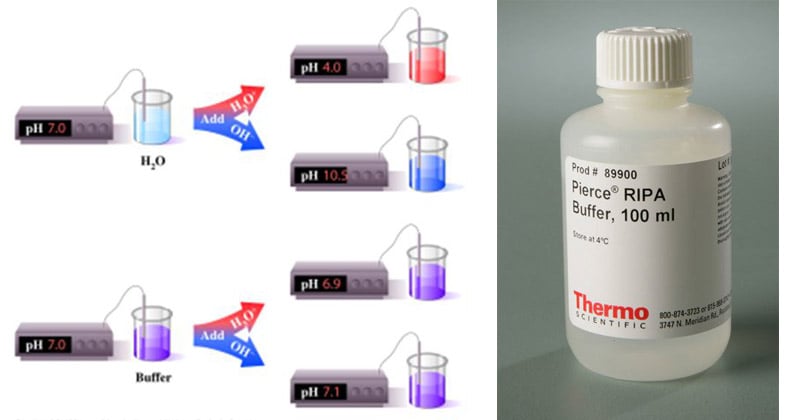- A buffer is an aqueous solution consisting of a mixture of a weak acid and its salt (acidic buffer) or a weak base and its salt (basic buffer) that resists a change in pH on the addition of either acid or base.
- Its pH changes very little when a small amount of strong acid or base is added to it and thus it is used to prevent changes in the pH of a solution.
- In practice, a buffer solution consists of an aqueous mixture of a weak acid and its conjugate base.
- The conjugate base component would neutralise any hydrogen ions generated during an experiment whilst the unionised acid would neutralise any base generated.

Interesting Science Videos
Extraction Buffer
Extraction buffers, also sometimes referred to as the lysis buffer is a buffer solution used for the purpose of breaking open cells for use in molecular biology experiments that analyze the compounds of the cells.
Most lysis buffers contain salts to regulate the acidity and osmolarity of the lysate.
- Normally extraction buffers are at an ionic strength (0.1–0.2 M) and pH (7.0–8.0) that is considered to be compatible with that found inside the cell.
- Tris or phosphate buffers are most commonly used.
- Each buffer choice has a specific pH range, so the buffer should be chosen based on whether the target substance is stable under a certain pH.
- Also, for buffers with similar pH ranges, it is important to consider whether the buffer is compatible with the targetconstituent of the cell.
Components of an Extraction Buffer
A range of other reagents may be included in the buffer for specific purposes. These include:
An anti-oxidant
- Within the cell the protein is in a highly reducing environment, but when released into the buffer it is exposed to a more oxidising environment.
- Since most proteins contain a number of free sulphydryl groups (from the amino acid cysteine) these can undergo oxidation to give inter- and intramolecular disulphide bridges.
- To prevent this, reducing agents such as dithiothreitol, b-mercaptoethanol, cysteine or reduced glutathione are often included in the buffer.
Enzyme inhibitors
- Once the cell is disrupted, proteolytic enzymes that were carefully packaged and controlled within the intact cells are released which may start to degrade proteins in the extract, including the protein of interest.
- To slow down unwanted proteolysis, all extraction and purification steps are carried out at 4oC, and in addition a range of protease inhibitors is included in the buffer.
- Common examples of inhibitors include: di-isopropylphosphofluoridate (DFP), phenylmethyl sulphonylfluoride (PMSF) and tosylphenylalanyl-chloromethylketone (TPCK) (all serine protease inhibitors); iodoacetate and cystatin (thiol protease inhibitors); pepstatin (aspartic protease inhibitor); EDTA and 1,10-phenanthroline (metalloprotease inhibitors); and amastatin and bestatin (exopeptidase inhibitors).
Enzyme substrate and cofactors
- Low levels of substrate are often included in extraction buffers when an enzyme is purified, since binding of substrate to the enzyme active site can stabilise the enzyme during purification processes.
- Where relevant, cofactors that otherwise might be lost during purification are also included to maintain enzyme activity.
EDTA
- This can be present to remove divalent metal ions that can react with thiol groups in proteins giving mercaptids.
Polyvinylpyrrolidone (PVP)
- This is often added to extraction buffers for plant tissue.
- Plant tissues contain considerable amounts of phenolic compounds that can bind to enzymes and other proteins by non-covalent forces, including hdrophobic, ionic and hydrogen bonds, causing protein precipitation.
- Insoluble PVP (which mimics the polypeptide backbone) is therefore added to adsorb the phenolic compounds which can then be removed by centrifugation.
- Thiol compounds (reducing agents) are also added to minimise the activity of phenol oxidases, and thus prevent the formation of quinones.
Sodium azide
- For buffers that are going to be stored for long periods of time, antibacterial and/or antifungal agents are sometimes added at low concentrations.
- Sodium azide is frequently used as a bacteriostatic agent.
Significance of an Extraction Buffer
- The primary purpose of lysis buffer is isolating the compounds of interest and keeping them in a stable environment.
- They are of enormous importance in practical biochemical work as many biochemical molecules are weak electrolytes and their ionic status varies with pH. Hence, there is a need to stabilise this ionic status during the course of a practical experiment.
References
- Wilson, K., Walker, J. (2018). Principles and Techniques of Biochemistry and Molecular Biology (8 eds.). Cambridge University Press: New York.
- https://en.wikipedia.org/wiki/Lysis_buffer
- https://slideplayer.com/slide/8257102/
- https://fac.ksu.edu.sa/sites/default/files/unit_5_-_buffer_solutins_ _subjects_0.pdf
- http://www.chem.cmu.edu/courses/09-106/notes/buffers.pdf
